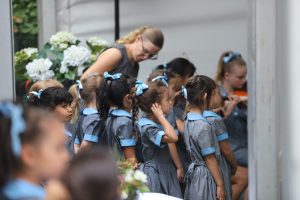Personalised Academic Learning Plans
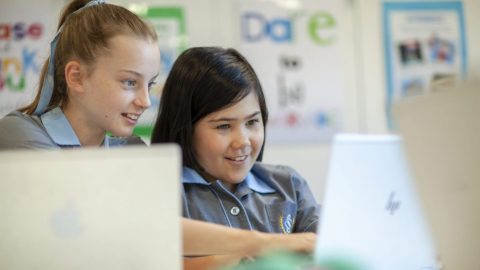
Personal Academic Learning Plans
The Junior School is moving towards more personalised learning in the areas of Literacy and Numeracy – the areas at the core of all learning in the primary years. In the first week of Term 2, you will receive your daughter’s Personalised Academic Learning Plan. The plan includes two goals – one for Writing (our key focus this year) and one for the strand ‘Number’; understanding of and skills in this strand are essential to success in all areas of Mathematics. The two goals were identified through analysis of your daughter’s writing samples and formative assessments in Mathematics.
This term, the Junior School staff have been working hard at analysing students’ writing. Teachers from each year level spent a morning with the Head and Deputy Head of Junior School analysing the writing of every student to identify:
- Areas of strength across the year level cohort.
- The next stage of focus at:
- Year level
- Student level.
Once analysed, goals were set. Students with like goals were grouped for targeted teaching.
In Mathematics, teachers have undertaken formative assessments and identified areas for focus for each student. Again, students with like needs have been grouped and goals determined.
The plan is set out under the following headings:
| Target Goals | Instructional Activities/Method | Success Criteria | Date when Achieved |
| These goals focus on the next main step your daughter needs to work on to make progress in this area. |
This section is divided in two: At school: What the teacher will be doing when working with your daughter’s group. At home you can: Provides some activities, strategies, websites or film clips you may choose to do/watch at home to support our efforts at school. |
This sets out what we are looking for in your daughter’s work at the next assessment. | The date at which the teacher feels your daughter is consistently demonstrating this goal. |
Please note: the term ‘teachers’ may include classroom teachers, Learning Plus staff and teachers from the Senior School.
It is our belief that providing a Personalised Learning Plan, targeting the next stage of learning for your daughter, will provide:
- The best opportunity for good progress to be made.
- Knowledge and some ideas on how you might support her learning at home.
We look forward to seeing our new plans in action and your daughter benefitting from her Personalised Learning Plan. If you have any queries pertaining to her goals, please contact your daughter’s teacher.
I welcome feedback on this initiative.
Term Overviews
Next term also sees the start of Term Overviews being sent home. These overviews set out the learning planned for your daughter’s Year Level in every subject. These overviews will also be available on the portal, where a list of useful websites will also be attached. Having the websites listed on the portal allows for easy copying and pasting into search engines.
Please note: these websites were present, relevant and appropriate at the time of writing.
Learning Number Facts
One of the biggest problems holding back many students in Mathematics is developing a quick recall of their number facts.
In the first fours years of schooling, students should be able to quickly recall:
- Additions to 10
- Subtractions from 10
- Up to 10 x 10 times tables
- Divisions under 100 i.e. 100÷10.
The emphasis here is on quick recall – usually answering in a second.
As a guideline, girls should know their addition and subtraction facts really well by the end of Year 1 and their multiplication and division facts by the end of Year 4 (hopefully earlier).
Teachers spend much time on teaching students about these concepts, often getting them to count on their fingers, using a ruler, counting in ‘5s’, but these strategies are mostly about helping students understand the concept. They were never meant as strategies to be used for years. If your daughter is spending time thinking about the answer, using her fingers or trying to work the answer out in her head, she does not know them.
When talking to girls about their struggles with number facts, I often hear that they think they have a memory problem; however, when asked about the lyrics to songs, they can recite them really well – so no memory issues.
The best strategy is to learn them in small groups and to practise daily. Stick to one method – do not confuse them with different methods for different facts.
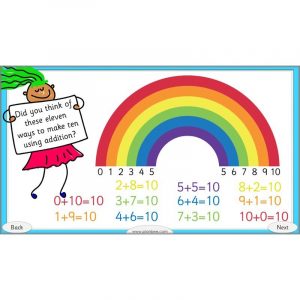
Strategy
I find flash cards with the sum on the front and the answer on the back work best.
Start with the ones your daughter thinks she knows, like the 2 x tables. Give her the cards and get her to learn them. Once she thinks she knows them, give them a shuffle and, like playing snap, put down a card – sum side up. If she gets it correct, it goes to the right, if incorrect to the left. Remember, she must answer in a second, if not, it goes on the left side. At the end, the left side cards are the only ones she needs to learn. Keep playing and shuffling until she has quick recall of all cards. At this point, you can make it fun, by getting her to challenge someone – maybe Dad or an older sister or brother. Do not hold back, really challenge her so you let her know the standard of quick recall she has to reach. When she eventually wins, she will have very quick recall and be proud of herself. She will also have faith in the method.
The next step is to learn another set. Once she thinks she knows them, include those cards in with the previous set, shuffle and repeat the process above.
The advantages of this process:
- You are getting her to learn in manageable sets.
- The game component keeps it interesting and fun – she will want to be able to eventually beat you, and she will, as her reflexes are quicker!
- Only learning those put to the left, means she is only learning those she cannot recall in a second – not the whole lot.
- Shuffling the new cards in with the old means she is constantly revising and not forgetting the previous set.
- The pack of cards she now knows is getting bigger and bigger and so are the games!
I have used this method for years. I would work with girls in Years 4 to 6 who did not know their times tables and tell them we would be learning number facts until they could beat me. Most started off thinking they would be there forever; however, the fun kicks in and they get a glimpse that they might be able to beat me when they get one fact faster than me. I always played hard and gave it my best. I told them I did not go home every night and learn them; I learnt them and knew them way back in Year 4. I explained that I knew them like I knew my phone number or my name or my address – I do not have to think and work them out, I just knew them, and that is the standard we want them to get to.
If anyone, wants a demonstration of this process, I would be happy to do so. Good luck everyone and please have lots of fun and good competition along the way.
Blue Ribbons
I have noticed a number of girls without their blue ribbons. Mums and Dads, could you please check before leaving the house. Tying the ribbon to your daughter’s hair band first before putting hair in pony tails is a great way to stop them sliding off. It saved me metres of ribbon with my daughter!
Ms Karen McArdle, Head of Junior School
Year 3 Writing Exercise
The Year 3 students have been focussing on writing narratives this term. Earlier in the term, they did a free piece of writing from which we determined some areas of focus for our teaching. We have focused on teaching the students a variety of writing skills and techniques such as the structure of compound sentences and how to include some figurative language devices in their own writing. We have also identified and used sentence patterns to assist in the development of their writing. We have been delighted by the improvement in their writing and have included some samples below:
When the sun rose, a boy in a ski jacket and denim shorts swung happily in his backyard. In the backyard, there were rocks, rough and dirty. There were trees blowing in the wind and one particular tree that blew the least had a big branch falling gracefully into the lake. The branch reminded the boy of monkey bars. Mountains with snow falling were far away, but still able to be seen easily. At the edge of the land, a calming lake stood with ginormous, grey, smooth rocks poking out. – Holly Farrer, Year 3H.
One clear, crisp morning a young boy was gazing out at the astonishing bright sky and the ripples on the lake dancing gracefully in the gentle breeze. The soft breeze swayed the boy gently, side to side, on the swing. The boy could hear the rocks shuffling and the birds chirping. It was a soft and calming sound. He stared up at the mountains and watched the snow gradually making its way down, disintegrating as it went. – Berry Roberts, Year 3H.
As the sun started to rise, a lonely, little boy swang unhurriedly on an old swing in Queenstown. The swing was connected to an elderly tree. On the opposite side of the tree was a lake, quiet and still, where rocks as grey as a herd of elephants lay. The beautiful snow-capped mountains were still and as snowy as a polar bear. The little boy swang faster as the lake moved quicker, making little ripples. The boy glanced at the beautiful emerald green leaves shining in the sunshine. – Alexia Chatfield, Year 3H.
As dawn came, an amazing, polite, little boy staggered slowly over to his swing in Germany. Surrounding the swing, were rocks kissing the water. Opposite the calm, still water were trees with leaves as green as a caterpillar. As the trees were whistling, the boy was captivated by the sounds he could hear. Alongside the trees was a lake as calm as a bird sleeping in a nest, soft and quiet. – Clara Barry, Year 3B.
One golden, sun-filled morning, a little boy as tall as a dwarf, approached a tiny tyre swing. He hopped onto the rickety swing quietly and then glared around him. There were pebbles the size of bullets. In the distance, there were snow-capped mountains. He glanced at the gigantic oak tree and admired how its green emerald leaves shone in the sunlight. He started staring beyond this evergreen tree into the crystal, clear lake. He could faintly see his own reflection. – Annika Gill, Year 3B.
One sunny day, a friendly, gentle boy, approached a swing at the riverbank. Underneath the swing were rocks as grey as elephants. The surrounding trees were as green as luscious grass and they came in all sorts of sizes. Some were as enormous as mountains while others were as small as shrubs. – Coco Lutz, Year 3B.
-
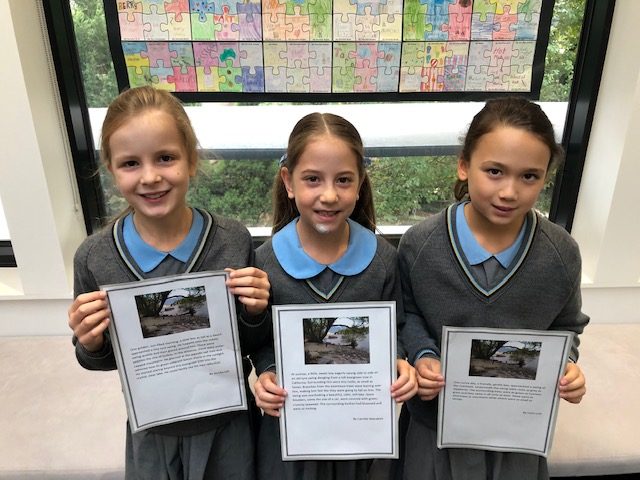
Annika Gill, Camilla Aberdeen and Coco Lutz.
-
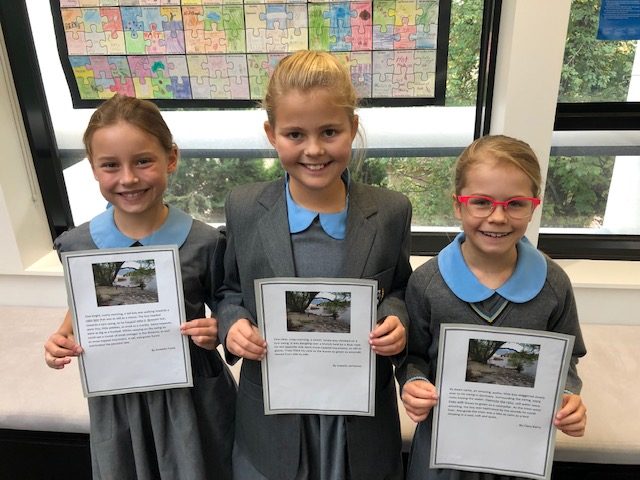
Arabella Foote, Isabella Jamieson and Clara Barry.
-
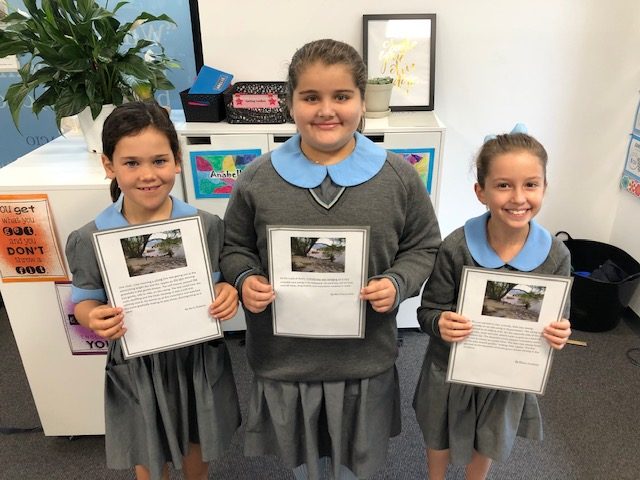
Berry Roberts, Mia'Chanel Kelly and Alexia Chatfield.
-
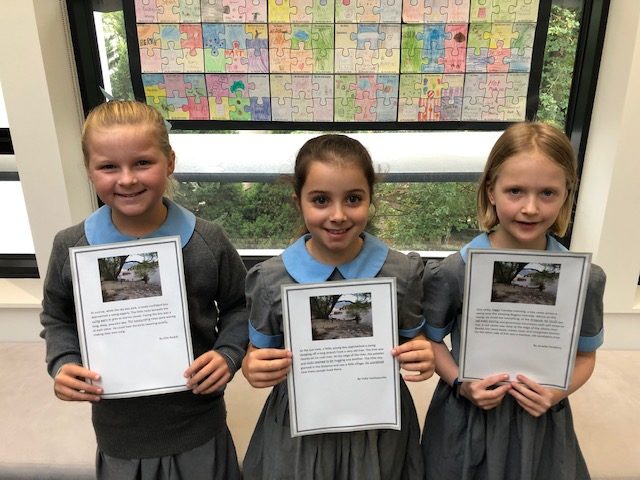
Ellie Rodski, India Vasilopoulos and Amelie Favaloro.
-
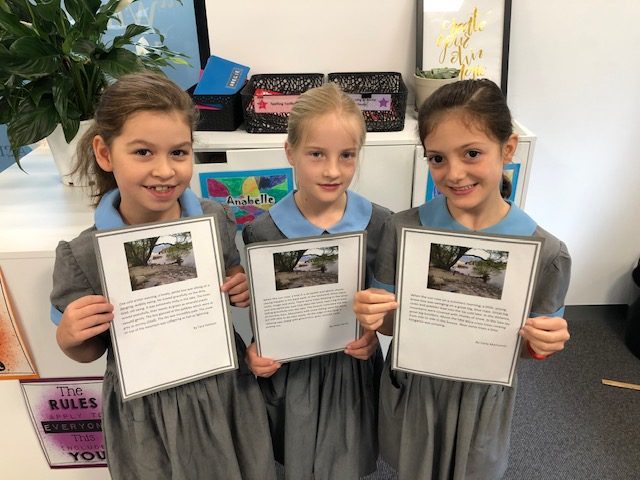
Holly Farrer, Tara Pattison and Carla Martuccio.
-
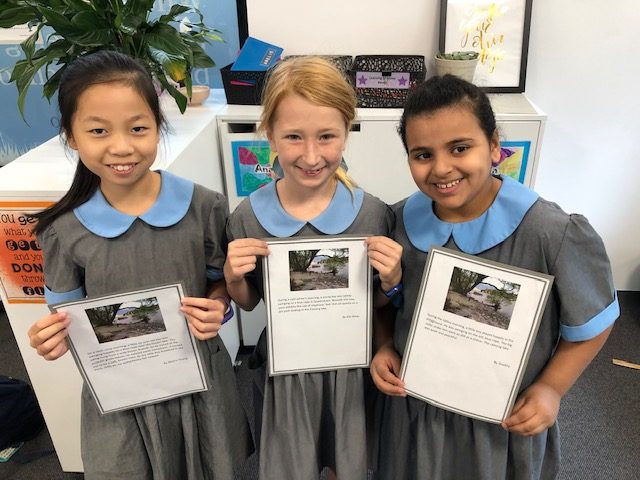
Jiajun (Jessica) Huang, Alie Belan and Shaikha Aljneibi.
Mrs Lola Ballis and Ms Emma Harty, Year 3 Teachers


